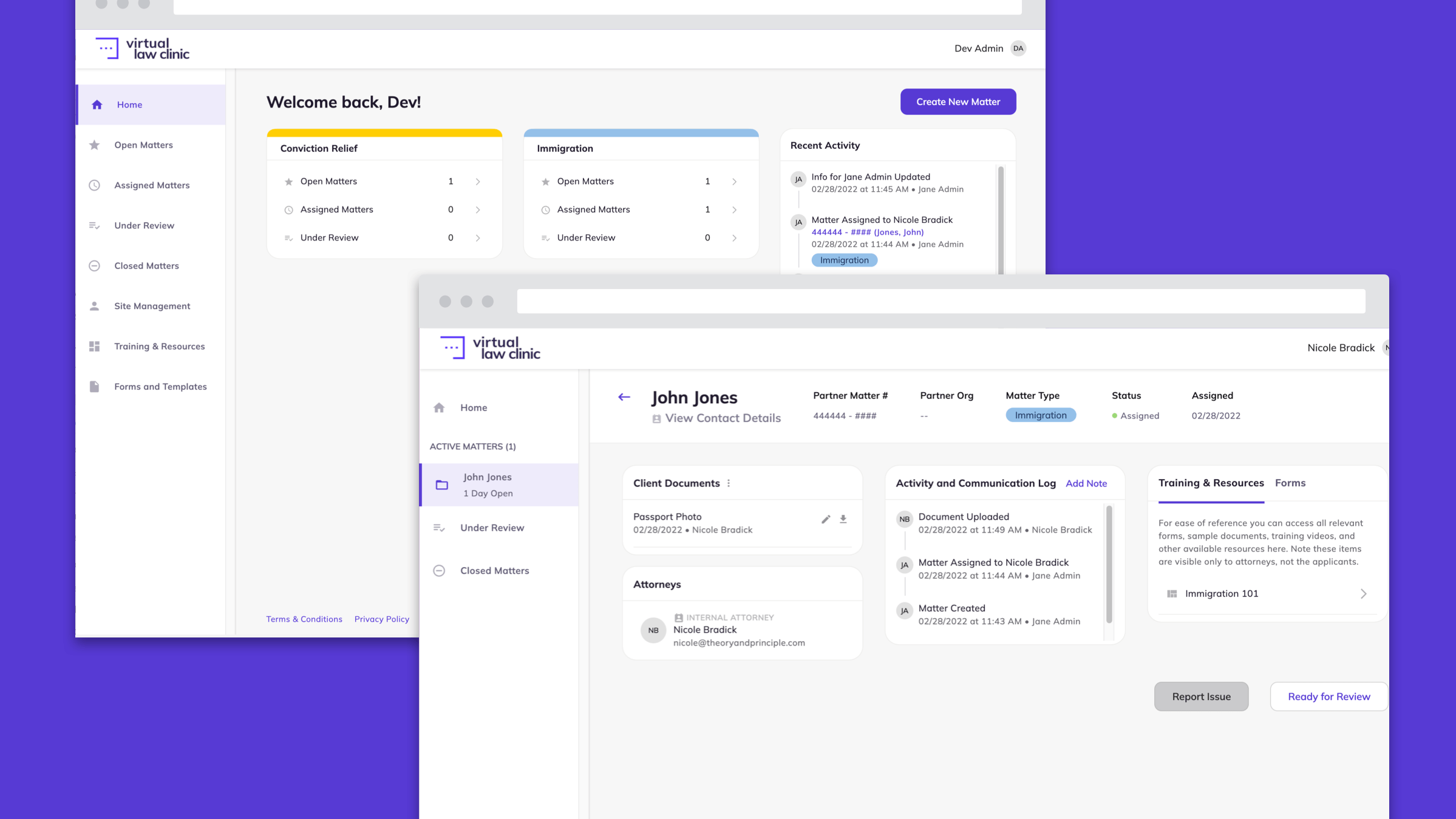A soon-to-launch product will make it easier for law firms and legal organizations to manage their pro bono matters, providing an administrative platform for assigning matters to lawyers, monitoring case statuses, documenting outcomes, and providing training materials and forms.
Called Virtual Law Clinic, it is the second product to come out of Theory and Principle, the legal technology design and development company that more typically develops products for others. Last year, it released its first product, Map Engine, in a partnership with Sente Advisors, a legal tech innovation consultancy.
Virtual Law Clinic is currently in beta testing and will be released to the market in March, Nicole Bradick, CEO of Theory and Principle, told me during a recent demonstration of the product.

Nicole Bradick
In February, the law firm Simpson Thacher & Bartlett deployed its own pro bono management tool, ACCESS by Simpson Thacher, built on Theory and Principle’s Virtual Law Clinic platform. Simpson Thacher provided funding to assist in the development of Virtual Law Clinic, but has no ownership stake in the product.
“We wanted a platform that could replicate the ease of our in-person pro bono clinics where, for example, the pro bono client hands us their documents and our volunteer attorneys work together to complete a benefits application,” said Harlene Katzman, Simpson Thacher’s pro bono counsel and director.
“ACCESS by Simpson Thacher does this and more, allowing our lawyers to work together and communicate virtually, enabling clients to provide documents through accessible technology and facilitating the review of the work by the legal services partner, all in one secure location.”
Bradick said she expects the Virtual Law Clinic to be used by law firms, corporate legal departments, universities and legal services organizations. Although she has not set final pricing, it will be sold on a subscription basis and will likely cost in the range of $6,000 to $35,000 annually, depending on the type of organization and its size.
Managing Pro Bono Cases
The platform has different interfaces for administrators who are coordinating pro bono matters and lawyers who are handling them. There is also a limited interface for clients.
“For the administrators, this provides full pro bono matter management, the ability to create training resources and forms and templates, and the ability to assign matters and review matters, as well as monitor outcomes,” Bradick told me.
The administrator — who will typically be the organization’s pro bono manager — works from a dashboard that provides a snapshot of matters and recent activity. The dashboard shows matters by their type, such as eviction or immigration, and an administrator can create as many types as needed.
From the dashboard, the administrator can open new matters and assign them to attorneys. In making assignments, the administrator is able to see each attorney’s current workload, so matters can be apportioned according to capacity.
Completed matters are send back to the administrator for review before the administrator closes them out. The platform provides tools for tracking matter outcomes.
Also from the dashboard, the administrator can add training materials and resources and forms and templates. Materials and forms can be tagged to associate them with matter types.
The lawyer-side interface also provides a dashboard where the lawyer can see open and closed matters and access training materials and forms.
For each matter assigned to a lawyer, the lawyer can see which other lawyers are on the matter team, review an activity log showing messaging and document activity, and access forms and training materials pertinent to the matter. From the platform, a lawyer can request and receive documents from the client and see the documents that have been provided.
The platform provides access for lawyers both within and outside an organization, to enable collaboration in situations when, for example, a lawyer within a firm is working on a matter together with a lawyer at a legal services agency. (Adding partner organizations is done by the administrator.)
The client interface is fairly simple, but is designed with a mobile-first approach that makes it easy for clients to use. Clients receive a document request by email, and then can upload documents by taking a photo of them, requiring only their emaid address to log in.
Bradick said she plans to soon add the ability to send and receive text messages with clients.
Virtual Law Clinic is not intended to be a full case or matter management platform. Bradick said she is exploring potential integrations with practice management platforms such as Intapp or Clio, as well as integrations with document management systems.
“For me, a big part of this is I want attorneys to feel like they can take more pro bono matters because they have an easy way to do it,” Bradick said. “We’re making this foolproof by giving them all the documents and everything in one space and making it an attractive experience.”
 Robert Ambrogi Blog
Robert Ambrogi Blog